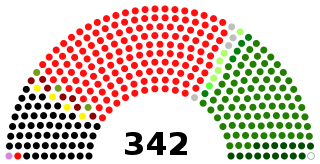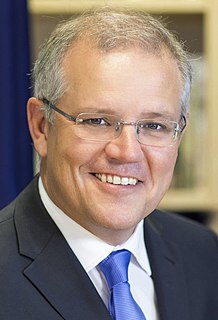
The Premier of Queensland is the head of government in the Australian state of Queensland.

The Senate is the upper house of the bicameral Parliament of Australia, the lower house being the House of Representatives. The composition and powers of the Senate are established in Chapter I of the Constitution of Australia. There are a total of 76 Senators: 12 are elected from each of the six states regardless of population and 2 from each of the two autonomous internal territories. Senators are popularly elected under the single transferable vote system of proportional representation.

The Rajya Sabha or Council of States is the upper house of the Parliament of India. Membership of Rajya Sabha is limited by the Constitution to a maximum of 250 members, and current laws have provision for 245 members. Most of the members of the House are indirectly elected by the members of state and territorial legislatures using single transferable votes, while the President can appoint 12 members for their contributions to art, literature, science, and social services. Members sit for staggered terms lasting six years, with a third of the members up for election every two years.

The High Court of Australia is the supreme court in the Australian court hierarchy and the final court of appeal in Australia. It has both original and appellate jurisdiction, the power of judicial review over laws passed by the Parliament of Australia and the parliaments of the states, and the ability to interpret the Constitution of Australia and thereby shape the development of federalism in Australia.

The Legislative Council, or upper house, is one of the two chambers of the Parliament of South Australia. Its central purpose is to act as a house of review for legislation passed through the lower house, the House of Assembly. It sits in Parliament House in the state capital, Adelaide.
In the Parliament of Australia, a casual vacancy arises when a member of either the Senate or the House of Representatives:

The National Assembly is the lower house of the bicameral Majlis-e-Shura, which also comprises the President of Pakistan and Senate of Pakistan. The National Assembly and the Senate both convene at Parliament House in Islamabad. The National Assembly is a democratically elected body consisting of a total of 336 members, before 25th ammendment they used to be 342' who are referred to as Members of the National Assembly (MNAs), of which 272 are directly elected members and 70 reserved seats for women and religious minorities. A political party must secure 137 seats to obtain and preserve a majority.

A double dissolution is a procedure permitted under the Australian Constitution to resolve deadlocks in the bicameral Parliament of Australia between the House of Representatives and the Senate. A double dissolution is the only circumstance in which the entire Senate can be dissolved.
A joint sitting of the Australian parliament was convened in 1974, in which members of the Senate and House of Representatives sat together as a single legislative body. The joint sitting was held on 6 and 7 August 1974, following the double dissolution 1974 federal election, and remains the only time that members of both houses of the federal parliament have sat together as a single legislative body pursuant to section 57 of the Constitution.

The South Africa Act 1909 was an Act of the British Parliament which created the Union of South Africa from the British colonies of the Cape of Good Hope, Natal, Orange River Colony, and Transvaal. The Act also made provisions for admitting Rhodesia as a fifth province of the Union in the future, but Rhodesian colonists rejected this option in a referendum held in 1922. The South Africa Act was the third major piece of legislation passed by the Parliament of the United Kingdom with the intent of uniting various British colonies and granting them some degree of autonomy. Earlier, the British North America Act, 1867 had united three colonies and the Commonwealth of Australia Constitution Act, 1900 had united the Australian colonies.
The law of Malaysia is mainly based on the common law legal system. This was a direct result of the colonisation of Malaya, Sarawak, and North Borneo by Britain between the early 19th century to 1960s. The supreme law of the land—the Constitution of Malaysia—sets out the legal framework and rights of Malaysian citizens.
Section 44 of the Australian Constitution lists the grounds for disqualification on who may become a candidate for election to the Parliament of Australia. It has generally arisen for consideration by the High Court sitting in its capacity as the Court of Disputed Returns. It has been reviewed several times, but has not been amended. Following several disqualifications under sub-section 44(i), a new review of the whole section was instituted on 28 November 2017.
This is a list of members of the Australian Senate from 1951 to 1953. The 28 April 1951 election was a double dissolution called by Prime Minister of Australia Robert Menzies in an attempt to gain control of the Senate and to pass a bill to ban the Communist Party of Australia, if necessary at a joint sitting of both houses. All 121 seats in the House of Representatives, and all 60 seats in the Senate were up for election. The incumbent Liberal Party of Australia led by Menzies with coalition partner the Country Party led by Arthur Fadden defeated the Australian Labor Party led by Ben Chifley and gained control of the Senate with 32 seats to Labor's 28.
This article is about Joint meetings of the Australian Parliament.

Chapter I of the Constitution of Australia establishes the Parliament of Australia and its role as the legislative branch of the Government of Australia. The chapter consists of 60 sections which are organised into 5 parts.
Section 43 of the Constitution of Australia prevents a person from being a member of both houses of the Parliament of Australia. Section 43 states:
A member of either House of the Parliament shall be incapable of being chosen or of sitting as a member of the other House.
Section 46 of the Constitution of Australia provides that if a Senator or member of the House of Representatives is constitutionally ineligible or disqualified from holding that position, they will be liable to pay any person who sues for it 100 pounds for every day that they have sat. With the introduction of the Australian dollar on 14 February 1966, where 100 pounds equaled A$200.

The 2019 Australian federal election will elect members of the 46th Parliament of Australia. The election will be called following the dissolution or expiry of the 45th Parliament as elected at the 2016 double dissolution federal election.






